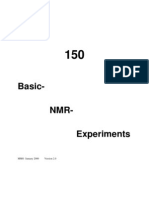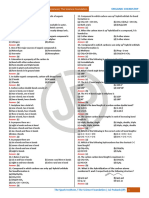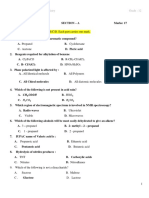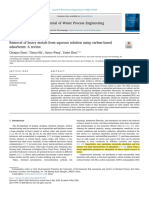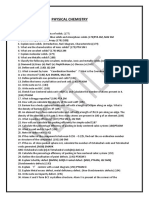Chemistry Multiple Choice Questions
Uploaded by
Chinni KrishnaChemistry Multiple Choice Questions
Uploaded by
Chinni KrishnaArts, Commerce and Science College, Bodwad.
Question Bank
S.Y. B.Sc. Sem-III Subject: - Organic & Inorganic Chemistry (Chem-II)
------------------------------------------------------------------------------------------------------------------
Multiple Choice Questions
1. Optical activity is shown by a molecule which---------
a) Contains at least 3 asymmetric centers
b) is asymmetric or dissymmetric as whole.
c) has plane of symmetry.
d) has a center of symmetry.
2. An asymmetric carbon atom has---------
a) one different atom or group.
b) two different atom or group.
c) three different atom or group.
d) four different atom or group.
3. In the complete rotation of butane from 0o to 360o the gauche conformation appear---------
a) Once b) Twice c) Thrice d) Four times.
4. In structural representation of molecule the prefixes Z and E stands for ---------
a) Zigle - Erythro b) Zusammen – Estrogen
c) Zeigle - Erhard d) Zusammen – Entgegen.
5. Racemic mixture is equimolar concentration ---------
a) Enantiomers b) Diastereomers
c) Enantiomer and meso compound d) None of these
6. The priority sequence for the hydrogen isotopes is---------
a) H > D > T b) T > D > H c) H > T > D d) D > T > H
7. In the R-S notation, the prefixes R and S stands for ---------
a) Rectus-simiantus b) Rectus-sinister
c) Rotamer-simiantus d) Rotamer-sinister.
8. ---------is the most stable conformation of n-butane.
a) Gauche b) Fully eclipsed c) Anti or staggered d) Partially eclipsed.
9. The atoms or groups which are behind the plane of the paper are shown by ------
a) Thick line b) Normal lines c) Dotted lines d) Zig-zag lines
10. The prefixes used in the nomenclature of stereoisomer of oximes are ------
a) Cis-trans b) Z-E c) Syn-anti d) Eclipsed-Staggered.
11. Which of the following is not a projection formula.
a) Newman b) Wedge c) Fischer d) Newton
12. The light consisting of only one wavelength is called as…………………light
a) Polarized b) Monochromatic c) Visible d) Invisible
13. The plane polarized light vibrates only in ……………..plane.
a) One b) two c) Many d) Does not vibrate
14. The instrument used to measure optical rotation is……..
a) Polarimeter b) Slit c) Nicol prism d) Microscope
15. The compound which contains chiral centre but, optically inactive is called……..
a) Dextrorotatory b) Levorotatory c) Enantiomer d) Meso compound
16. The stereoisomers which are not mirror images of each other are called as…….
a) Epimers b) Conformers c) Diastereomers d) None of these
17. Which of the following type of isomer contain similar group on same side of the double bond
a) Cis b) Trans c) Eclipsed d) Staggered
18. The stereoisomers which can be interconverted by rotation of single bond are called..
a) Configurational isomers b) Geometrical isomers
c) Conformational isomers d) Chain isomers
19. The isomers which differ in the position of substituent are called…….
a) Position isomers b) Chain isomers c) Functional isomers d) Metamers
20. The most unstable conformation of cyclohexane is
a) Boat b) Half chair c) Twist chair d) Chair
21. Eclipsed bonds are seen in ………………..conformation of cyclohexane
a) Boat b) Half chair c) Twist chair d) Chair
22. Chair-chair interconversion is possible by,
a) stretching b) bending c) ring flipping d) twisting
23. The boat conformation of cyclohexane is less stable due to…………hydrogens
a) equatorial b) axial c) all d) flag-pole
24. ………………..conformation of cyclohexane is free of angle & torsional strain
a) Boat b) Half chair c) Twist chair d) Chair
25. Dimethyl ether and ethyl alcohol are examples of ……………….isomerism
a) Position b) Chain c) Functional group d) Metamers
26. The angle between Hydrogen on near carbon and farther carbon is called……
a) Dihedral angle b) rotational angle c) rectangle d) cross angle
27. The full form of CIP is
a) Cahn-Ingold-Prelog b) Cane-India-Pacific
c) China-Indonesia-Paris d) None of the above
28. The priority sequence is given on the basis of…
a) Atomic size b) Atomic number c) Electronegativity d) Energy
29. The elements of symmetry are useful to determine…………………..of molecule.
a) reactivity b) symmetry c) polarizability d) size
30. The carbon atom having four different substituents is called as…………
a) Chiral carbon b) Good carbon c) Bad carbon d) symmetric carbon
31. In polarimeter, sample is placed in……
a) Nicol prism b) Source c) Analyzer d) Polarimeter tube
32. In Newman projection formula, front carbon atom is shown by a………….
a) Circle b) Ellipse c) Dot d) Line
33. Pyridine undergo electrophilic substitution reaction at position number-
a) 2 b) 3 c) 4 d) 1
34. Furan, pyrrole and thiophene undergo substitution at ____position
a) 1 b) 2 c) 3 d) 4
35. _____ is not a heterocyclic aromatic compound.
a) Furan b) Pyrrole c) Thiophene d) Naphthalene
36. _____ is a 6 membered heterocyclic compound.
a) Furan b) Pyrrole c) Thiophene d) Pyridine
37. Furan on reaction with CHCl3/KOH gives_____
a) 2-acetyl furan b) Furfural c) 3-acetyl furan d) 2-chloro furan
38. Thiophene cannot be prepared from
a) acetylene b) n-butane c) ethylene d) sodium succinate
39. Molecular formula of pyrrole is _____
a) C4H5N b) C4H4N c) C5H5N d) C6H6N
40. Pyrrole on hydrogenation gives _____
a) Piperidine b) 2-hydro pyrrole c) Pyrrolidene d) None
41. Pyridine on heating with nitrating mixture gives _____
a) 1-nitro pyridine b) 2-nitro pyridine c) 3-nitro pyridine d) 4-nitro pyridine
42. Oxidation of isoquinoline with KMnO4 gives …………….. as one of the products.
a) Benzoic acid b) Pyridine c) Phthalic acid d) Salicylic acid.
43. Electrophilic aromatic substitutions in quinoline takes place at ………… positions.
a) 4 b) 2 c) 5 and 8 d) 2 and 4
44. 2- Aza naphthalene is the name of …………………
a) Pyridine b) quinoline c) isoquinoline d) indole
45. Quinoline is …………………. compound.
a) Homocyclic b) Heterocyclic c) aliphatic d) Saturated
46. Electrophilic substitution reactions in Naphthalene takes place at …………position
a) alpha b) beta c) delta d) omega
47. The C1-C2 bond length in Naphthalene is,
a) 1.365 A0 b) 1.363 A0 c) 1.404 A0 d) 1.425 A0
48. The C2-C3 bond length in Naphthalene is,
a) 1.365 A0 b) 1.363 A0 c) 1.404 A0 d) 1.425 A0
49. Naphthalene on sulphonation by conc. Sulphuric acid at 800 C gives…….
a) α-naphthalene sulphonic acid b) ꞵ- naphthalene sulphonic acid
c) ꞅ- naphthalene sulphonic acid d) d- naphthalene sulphonic acid
50. Naphthalene on reaction with CH3COCl and AlCl3 in presence of solvent CCl4 gives
a) 2-aceto naphthalene b) 1-aceto naphthalene
c) 3-aceto naphthalene d) 4-aceto naphthalene
51. Naphthalene on reaction with CH3COCl and AlCl3 in presence of solvent Nitrobenzene gives
a) 2-aceto naphthalene b) 1-aceto naphthalene
c) 3-aceto naphthalene d) 4-aceto naphthalene
52. Which of the following catalyst is used in Friedel-Crafts acylation
a) Lewis acid b) Lewis base c) Sulphuric acid d) KOH
53. Which of the following is not an oxidizing agent
a) KMnO4 b) CrO3 c) V2O5 d) KCl
54. Naphthalene on reduction with sodium and ethyl alcohol gives……
a) Tetralin b) Decalin c) 1-4, dihydro naphthalene d) Pyrrole
55. Naphthalene on reduction with sodium and isopentyl alcohol gives……
a) Tetralin b) Decalin c) 1-4, dihydro naphthalene d) Pyrrole
56. Naphthalene on reduction with H2/Pt gives……
a) Tetralin b) Decalin c) 1-4, dihydro naphthalene d) Pyrrole
57. Which of the following is nitrating mixture,
a) HCl/H2SO4 b) HNO3/H2SO4 c) H2/Pt d) All of these
58. The reduction using Zn-Hg/HCl is called as……….
a) Clemmenson’s reduction b) Birch reduction
c) Catalytic reduction d) Total reduction
59. Haworth synthesis is used to synthesize…………..
a) Pyridine b) Naphthalene c) Furan d) Pyrrole
60. 3-methyl pyridine is called as…..
a) Pyrrolidine b) Piperidine c) Acrolein d) Picoline
61. The removal of carboxyl group in the form of CO2 by heating is called,
a) Decarboxylation b) Elimination
c) Addition d) Substitution
62. The reaction using CHCl3/ KOH is called.
a) Freidel-Craft reaction b) Hydrogenation
c) Reimer-Tiemann reaction d) Sulphonation
63. According to solvent system concept, the compound which gives cation of solvent is….
a) acid b) Base c) Neutral d) Salt
64. According to solvent system concept, the compound which gives anion of solvent is….
a) acid b) Base c) Neutral d) Salt
65. According to solvent system concept, neutralization is
a) Reaction between acid and base to give salt
b) Reaction between acid and base to give salt and solvent
c) Reaction between acid and base to give water
d) Reaction between acid and base to give acid
66. Oxide ion donor is base. This is according to,
a) solvent system concept b) Lewis concept
c) Lux-Flood concept d) Bronsted concept
67. Oxide ion acceptor is acid. This is according to,
a) solvent system concept b) Lewis concept
c) Lux-Flood concept d) Bronsted concept
68. Electron pair acceptor species is acid. This is according to,
a) solvent system concept b) Lewis concept
c) Lux-Flood concept d) Bronsted concept
69. According to Lewis concept base is,
a) any species capable of donating electron pair
b) Any species capable of accepting electron pair
c) Substance donating H+ ion
d) Substance accepting H+ ion
70. Combination of ions or molecules of solute with solvent is called,
a) Neutralization b) Oxidation c) Reduction d) Solvation
71. BF3, AlCl3, GaCl3 are…………
a) Lewis acids b) Lewis bases c) Bronsted acids d) Bronsted bases
72. Combination of acid with base to form addition product or adduct. This according to,
a) solvent system concept b) Lewis concept
c) Lux-Flood concept d) Bronsted concept
73. All cations are acids and all anions are bases. This is according to,
a) solvent system concept b) Lewis concept
c) Lux-Flood concept d) Bronsted concept
74. NH3, H2O, ROH, ROR are……
a) Lewis acids b) Lewis bases
c) Lux-Flood acids d) Bronsted acids
75. According to generalized acid-base concept,
a) H+ is a base b) Free electron is acid c) Free electron is base d) -OH is acid
76. Solvent which brings ionization of solute to same extent is called as
a) Acidic solvent. b) Basic solvent c) Differentiating solvent. d) Levelling solvent.
77. Acidic solvents are,
a) Levelling for acids. b) Levelling for bases.
c) Differentiating for bases. d) None of the above.
78. Basic solvents are,
a) Levelling for acids. b) Levelling for bases.
c) Differentiating for acids. d) None of the above.
79. Substances used to increase ionization of acids or bases in medium are,
a) Oxidizing agents. b) Reducing agents.
c) Co-solvating agents. d) Redox agents.
80. Species having strong tendency to accept electrons & form ionic bond with base, are called
a) Hard base. b) Soft base. c) Hard acid. d) Soft acid.
81. Species in which valence electrons are easily distorted or polarized or donated, are called
a) Hard base. b) Soft base. c) Hard acid. d) Soft acid.
82. According to Pearson’s HSAB concept, Hard acid prefers to bind,
a) Hard base. b) Soft base. c) Hard acid. d) Soft acid.
83. According to Pearson’s HSAB concept, the product is more stable when,
a) Hard acid combines with soft base. b) Soft acid combines with Hard base.
c) Hard acid combines with Hard base. d) cannot be predicted.
84. Solute is a substance which dissolves in solvent and forms,
a) Solution b) Gas c) Film d) acid
85. Water has ……………dielectric constant.
a) Low b) Negative c) High d) Zero
86. Molten salts are,
a) Protic b) Aprotic c) Acidic d) Basic
87. Dissolved oxygen can be partly removed from solvent by
a) Exposing to sunlight b) Passing air
c) By bubbling nitrogen gas d) Cannot be removed
88. According to Electronic theory, Hard-Hard interactions involve,
a) Co-ordinate bonding b) Ionic bonding
c) Covalent bonding d) H-bonding
89. According to Electronic theory, Soft-Soft interactions involve,
a) Co-ordinate bonding b) Ionic bonding
c) Covalent bonding d) H-bonding
90. HSAB concept can be used to determine,
a) Stability of complexes b) Predicting feasibility of reactions
c) Solubility of compounds in a given solvent d) All the above
91. Decrease in the activity of a catalyst due to contamination is called as,
a) Poisoning of catalyst b) Dirtiness of catalyst
c) Arresting of catalyst d) None of above
92. Which of the following is a disadvantage of solvent system concept,
a) It requires solvent b) It requires clean apparatus
c) It requires large literature d) It is useless
93. The Lewis concept is,
a) Tedious b) Boring c) Broader d) Shorter
94. Lewis bases are ………….in complexes.
a) Metal ions b) Counter ion c) whole complex d) Ligands
95. The species with highest positive charge density is,
a) Strongest acid b) Strongest base c) Weakest acid d) Neutral
96. The species with highest negative charge density is,
a) Strongest acid b) Strongest base c) Weakest base d) Neutral
97. ……………solvents are used to determine the strength of acids & bases of a given series.
a) Levelling b) Differentiating c) Acidic d) Basic
98. Solvation takes place by,
a) Formation od co-ordinate bond b) ion-dipole interaction
c) Both a and b d) None of the above
99. In electrochemical reactions, solvent must have,
a) High dielectric constant b) Low dielectric constant
c) Zero dielectric constant d) Negative dielectric constant
100. Solvent ether reacts with oxygen in air on long exposure and forms,
a) Sulphides b) Nitriles c) Peroxides d) Hydrides
You might also like
- (Joseph Keddie, Alexander F. Routh) Fundamentals of Latex Film Formation50% (2)(Joseph Keddie, Alexander F. Routh) Fundamentals of Latex Film Formation299 pages
- Determination of Enthalpy Between Magnesium and HCLNo ratings yetDetermination of Enthalpy Between Magnesium and HCL6 pages
- Assignment Isomerism & Stereochemistry-2023No ratings yetAssignment Isomerism & Stereochemistry-20233 pages
- Mid - 2 Examinations Common To Cse&Eee: Chemistry DTNo ratings yetMid - 2 Examinations Common To Cse&Eee: Chemistry DT2 pages
- MedAchievers CHM 102 MOCK EXAM QUESTIONSNo ratings yetMedAchievers CHM 102 MOCK EXAM QUESTIONS6 pages
- Organic Chemistry I Questions for Tutorial-09!11!2022 (1)No ratings yetOrganic Chemistry I Questions for Tutorial-09!11!2022 (1)18 pages
- Activity 4 Introduction To StereochemistryNo ratings yetActivity 4 Introduction To Stereochemistry15 pages
- Assignment Ch - Basic Concepts of ChemistryNo ratings yetAssignment Ch - Basic Concepts of Chemistry8 pages
- 2016_AIPMT_CHEMISTRY_PAPER_Repaired_Rationalized_&_Non_RationalizedNo ratings yet2016_AIPMT_CHEMISTRY_PAPER_Repaired_Rationalized_&_Non_Rationalized6 pages
- Chemistry Class 11 Term II_set I_marking SchemeNo ratings yetChemistry Class 11 Term II_set I_marking Scheme6 pages
- CHM 103 TUTORIAL QUESTIONS BY HAY WHY OH AND GODSPEEDNo ratings yetCHM 103 TUTORIAL QUESTIONS BY HAY WHY OH AND GODSPEED32 pages
- Efficient Method For The Determination of The Activation Energy of Hydrogen Peroxide DecompositionNo ratings yetEfficient Method For The Determination of The Activation Energy of Hydrogen Peroxide Decomposition4 pages
- Adsorptive Solar Powered Ice Maker Experiments PDFNo ratings yetAdsorptive Solar Powered Ice Maker Experiments PDF15 pages
- (eBook PDF) General Chemistry 10th Edition pdf download100% (5)(eBook PDF) General Chemistry 10th Edition pdf download43 pages
- Proforma Synopsis For Ph.D. in Science (Physics) : 1. Name of The Project and Title of The ThesisNo ratings yetProforma Synopsis For Ph.D. in Science (Physics) : 1. Name of The Project and Title of The Thesis4 pages
- Form 4 Chapter 4.2 Specific Heat CapacityNo ratings yetForm 4 Chapter 4.2 Specific Heat Capacity11 pages
- Flashcards - Topic 1 Atomic Structure and The Periodic Table - Edexcel Chemistry A-LevelNo ratings yetFlashcards - Topic 1 Atomic Structure and The Periodic Table - Edexcel Chemistry A-Level131 pages
- Journal of Water Process Engineering: SciencedirectNo ratings yetJournal of Water Process Engineering: Sciencedirect13 pages
- Introduction To Manufacturing: Case Study: Thermometers-By: Bitisa KandelNo ratings yetIntroduction To Manufacturing: Case Study: Thermometers-By: Bitisa Kandel3 pages


